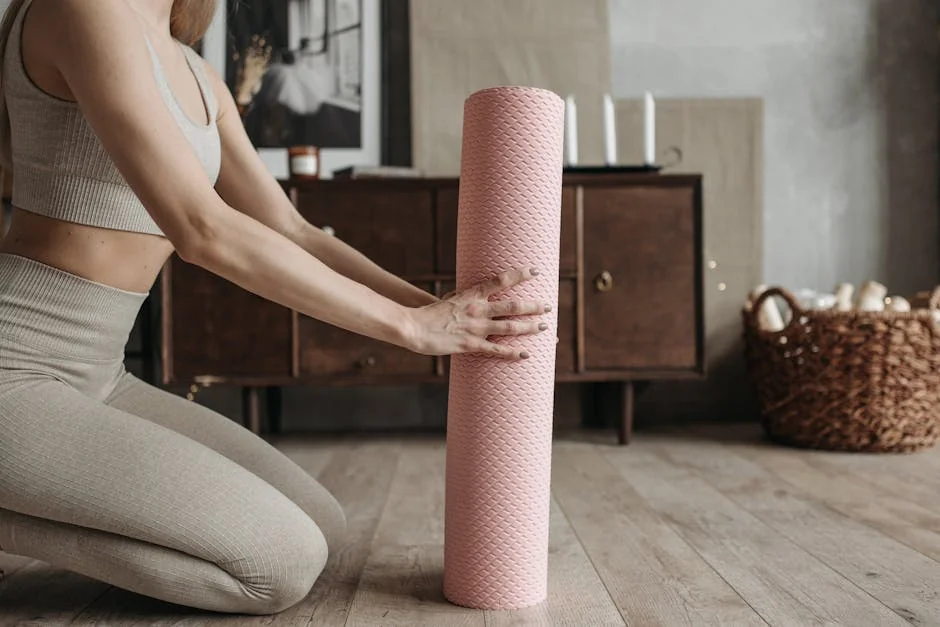Feeling overwhelmed and searching for a quiet corner of your own? You’re not alone. In our busy lives, having a dedicated sanctuary is a game-changer for any mindfulness practice. Learning how to set up a meditation space is your first step toward cultivating a consistent ritual for inner peace. This isn't about needing a spare room or a big budget; it's about intentionally carving out a small, personal haven where you can disconnect from the noise and reconnect with yourself.
This guide will walk you through transforming any nook—be it a closet corner or a sliver of your bedroom—into a powerful anchor for your practice. We’ll cover everything from choosing the perfect, quiet location to setting a soothing mood with lighting and scent. Get ready to discover simple, actionable steps for creating a sacred space that not only invites calm but also deeply supports your journey toward mindfulness, one breath at a time.
Choosing the Perfect Location for Your Meditation Space
The first step is selecting your spot. It doesn't need to be large; even a small, intentional area can become your personal sanctuary. The goal is to find a place that feels separate from the hustle of daily life.
Key considerations for your meditation corner include:
- Quiet and Low-Traffic: Look for a calm area like a bedroom corner, a walk-in closet, or a section of a home office that isn't used frequently.
- Consistency: Choose a spot you can return to daily. This consistency builds a powerful habit and a tangible sense of peace each time you sit down.
- Natural Light: A space near a window is ideal, as it provides a connection to the outside world and can be incredibly uplifting.
- Privacy: Ensure you feel comfortable and won't be easily interrupted by family members or roommates.
Decluttering for a Clear Mind
Your physical environment directly impacts your mental state. A cluttered space often leads to a cluttered mind, which is the opposite of what you want for your practice. Begin by clearing out the area of any unnecessary items.
- Physical Decluttering: Remove storage boxes, distracting electronics, or piles of laundry. The space should feel clean and simple.
- Energetic Cleansing: After tidying, you can clear the energy. This can be as simple as ringing a bell, gently smudging with sage, or just taking a moment to set a silent intention for peace.
- The Power of Empty Space: Remember that emptiness isn't a lack, but a container for potential. This clear area is now ready to be filled with calm and focus, which is especially helpful if you are looking for a meditation to clear the mind.
Setting the Mood with Ambiance and Atmosphere
This is where you transform your chosen corner into a true sanctuary by engaging the senses. The right atmosphere is crucial for creating a relaxing environment that helps you drop in quickly.
Sensory Elements for Deep Relaxation
- Lighting: Avoid harsh overhead lights. Instead, use soft, warm lighting from a dimmable lamp, a Himalayan salt lamp, or fairy lights. Natural light is always best when available.
- Scents: Incorporate aromatherapy to calm the mind. An essential oil diffuser with lavender for relaxation or sandalwood for grounding can be highly effective. Incense is another popular option.
- Sound: If your space isn't perfectly quiet, consider a small indoor water fountain for soothing sounds. A white noise machine or a playlist of gentle, instrumental music can also mask distracting noises.
Essential Items for Your Meditation Sanctuary
Gathering a few key items will support a comfortable and focused practice. This isn't about consumerism, but about choosing objects with intention to enhance your experience.
- Seating: The right support is essential. Choose a meditation cushion (zafu), a kneeling bench, or a straight-backed chair based on your flexibility. The goal is a comfortable, upright posture. If you're new to this, our guide on how to meditate a guide to self-discovery covers the fundamentals of posture and technique.
- Comfort: Keep a soft blanket or shawl nearby. It’s useful for warmth during longer sits and can provide a wonderful sense of security.
- Focus Points: Aids for concentration can be very helpful. This could be the flame of a candle, a small crystal, or a simple piece of art or statue placed at eye level. For a more advanced technique, you could explore how to visualise in meditation using such a point as a starting anchor.
- Personal Touches: Add one or two meaningful items, such as a fresh flower, a inspiring quote, or a smooth stone from a favorite walk.
Maintaining and Evolving Your Sacred Space
Your meditation space is a living part of your practice, not a one-time setup. Maintaining it ensures it remains an inviting and potent place for your daily ritual.
- Daily Tidying: Take 30 seconds after each session to neatify the space. Fluff your cushion, fold your blanket, and put any items back in their place. This small act keeps the energy fresh.
- Energetic Refreshing: If the space ever feels stagnant, repeat a simple cleansing practice like smudging or ringing a bell to reset the atmosphere.
- Seasonal Updates: Allow your space to evolve with you. You might change the blanket with the seasons, swap out the focus object, or introduce a new scent that calls to you. This keeps your practice feeling fresh and engaged, whether you're practicing seated stillness or preparing for a session of how to do walking meditation.
Creating a dedicated meditation space is a powerful step toward cultivating a consistent and meaningful practice. By prioritizing simplicity, personal comfort, and intentionality, you can transform even the smallest corner into a sanctuary for quiet reflection. The key takeaways are straightforward: choose a quiet, low-traffic area, keep it uncluttered, and introduce elements that engage your senses—such as soft lighting, a comfortable cushion, or a calming scent—to signal to your mind that it is time to unwind. This personal haven need not be elaborate; its primary purpose is to serve as a consistent anchor for your practice, making it easier to return to each day.
The true essence of this space lies not in its aesthetic perfection, but in the peace and mindfulness you cultivate within it. It is a physical reminder of your commitment to your own well-being. Now that you have the practical blueprint, the most important step remains: begin. Unroll your mat, light a candle, and take that first conscious breath. Your journey toward greater calm and clarity awaits in the serene space you have created.



